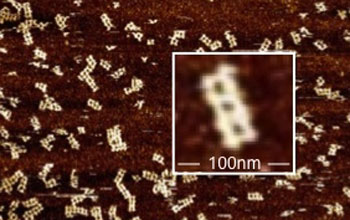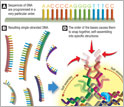News Release 12-223
Drag-and-Drop DNA
Novel technique aiding development of new cancer drugs

A collection of pharmaceutical molecules is shown after self-assembly.
December 4, 2012
This material is available primarily for archival purposes. Telephone numbers or other contact information may be out of date; please see current contact information at media contacts.
Using a simple "drag-and-drop" computer interface and DNA self-assembly techniques, researchers have developed a new approach for drug development that could drastically reduce the time required to create and test medications.
In work supported by a National Science Foundation (NSF) Small Business Innovation Research grant, researchers from Parabon® NanoLabs of Reston, Va., recently developed and began evaluating a drug for combating the lethal brain cancer glioblastoma multiforme.
Now, with the support of an NSF Technology Enhancement for Commercial Partnerships (TECP) grant, Parabon has partnered with Janssen Research & Development, LLC, part of the Janssen Pharmaceutical Companies of Johnson & Johnson, to use the technology to create and test the efficacy of a new prostate cancer drug.
"We can now 'print,' molecule by molecule, exactly the compound that we want," says Steven Armentrout, the principal investigator on the NSF grants and co-developer of Parabon's technology. "What differentiates our nanotechnology from others is our ability to rapidly, and precisely, specify the placement of every atom in a compound that we design."
The new technology is called the Parabon Essemblix™ Drug Development Platform, and it combines their computer-aided design (CAD) software called inSēquio™ with nanoscale fabrication technology.
Scientists work within inSēquio™ to design molecular pieces with specific, functional components. The software then optimizes the design using the Parabon Computation Grid, a cloud supercomputing platform that uses proprietary algorithms to search for sets of DNA sequences that can self-assemble those components.
"When designing a therapeutic compound, we combine knowledge of the cell receptors we are targeting or biological pathways we are trying to affect with an understanding of the linking chemistry that defines what is possible to assemble," says Hong Zhong, senior research scientist at Parabon and a collaborator on the grants. "It's a deliberate and methodical engineering process, which is quite different from most other drug development approaches in use today."
With the resulting sequences, the scientists chemically synthesize trillions of identical copies of the designed molecules. The process, from conception to production, can be performed in weeks, or even days--much faster than traditional drug discovery techniques that rely on trial and error for screening potentially useful compounds.
In vivo experiments, funded by the NSF SBIR award, validated the approach, and Parabon filed a provisional patent for its methods and compounds on May 4, 2011. The final application was published in 2012.
The process is characteristic of rational drug design, an effort to craft pharmaceuticals based on knowledge of how certain molecular pieces will work together in a biological system. For example, some molecules are good at finding cancer cells, while others are good at latching on to cancer cells, while still others are capable of killing cells. Working together as part of a larger molecule, these pieces could prove effective as a cancer treatment.
While there are other methods to create multi-component compounds, they generally take more time, and, most important, the majority of them lack the precise control over size, charge and the relative placement of components enabled by the new technology. The recent TECP grant provided a supplement to Parabon to support further research that will help the novel technologies meet market demands.
TECP grants are a mechanism available to NSF Phase II SBIR/STTR grantees, helping improve their commercial success by enabling them to build partnerships with larger companies and investors. Those partners generally require new products to meet set specifications and standards, and TECP supplemental awards provide funding for the research required to meet those parameters. As with Parabon and Janssen, the companies that partner with TECP grantees provide input that helps to further guide technological development.
"Partnerships are recognized as a critical success factor for small businesses commercializing technology," says Ruth Shuman, the NSF program director who oversees the NSF TECP effort. "However, potential partners frequently demand technical specifications and require proof-of-concept data as a prerequisite for partnership, requirements that are beyond the scope of small businesses' initial objectives. This supplemental funding enables small businesses to conduct additional research to meet the requirements of a corporate partner, potentially leading to commercial products and services, and a successful partnership."
The Parabon and Janssen researchers intend for their new prostate cancer drug to overcome several existing cancer-treatment obstacles. The drug design combines a toxin with a chemical that makes cancer cells susceptible to that toxin. Additionally, the drug incorporates components that improve delivery to cancer cells while avoiding healthy tissue, and chemical markers that allow researchers to monitor the drug's arrival at tumors. For the new compound, total design time plus synthesis time will be a matter of weeks.
"Currently, most drugs are developed using a screening technique where you try a lot of candidate compounds against targets to 'see what sticks'," says Armentrout. "Instead, we're designing very specific drugs based on their molecular structure, with target molecules that bind to receptors on specific types of cancer cells. In plug-and-play fashion, we can swap in or swap out any of the functional components, as needed, for a range of treatment approaches."
Concurrently, Parabon is developing other applications for the technology, including synthetic vaccines for biodefense and gene therapies that can target disease, based on information from an individual's genome. The technology also has applications outside of medicine, and Parabon's co-founders Chris Dwyer and Michael Norton are building upon the initial NSF-supported work to develop processes to create nanoscale logic gates, devices critical for computing, and molecular nanosensors.
For detailed information and highlights about NSF support for research at universities and small businesses in the Commonwealth of Virginia, access the SEE Innovation website on Research.gov.
-NSF-
-
This illustration depicts the new Essemblix nano-manufacturing technology.
Credit and Larger Version
Media Contacts
Joshua A. Chamot, NSF, (703) 292-7730, email: jchamot@nsf.gov
Paula Gawthorp-Armentrout, Parabon NanoLabs, (703) 689-9689 x207, email: parmentrout@parabon.com
Program Contacts
Ruth M. Shuman, NSF, (703) 292-2160, email: rshuman@nsf.gov
Principal Investigators
Steven Armentrout, Co-Founder and CEO Parabon NanoLabs, (703) 689-9689 x201, email: steve@parabon.com
The U.S. National Science Foundation propels the nation forward by advancing fundamental research in all fields of science and engineering. NSF supports research and people by providing facilities, instruments and funding to support their ingenuity and sustain the U.S. as a global leader in research and innovation. With a fiscal year 2023 budget of $9.5 billion, NSF funds reach all 50 states through grants to nearly 2,000 colleges, universities and institutions. Each year, NSF receives more than 40,000 competitive proposals and makes about 11,000 new awards. Those awards include support for cooperative research with industry, Arctic and Antarctic research and operations, and U.S. participation in international scientific efforts.
Connect with us online
NSF website: nsf.gov
NSF News: nsf.gov/news
For News Media: nsf.gov/news/newsroom
Statistics: nsf.gov/statistics/
Awards database: nsf.gov/awardsearch/
Follow us on social
Twitter: twitter.com/NSF
Facebook: facebook.com/US.NSF
Instagram: instagram.com/nsfgov

